تحليل الأسباب الجذرية لحادث تسريب الكلورين في ميناء العقبة 2022
Root Cause Analysis for Aqaba Chlorine Release Incident 2022
مدينة العقبة هي الميناء الوحيد في الأردن.
تسلسل الأحداث:
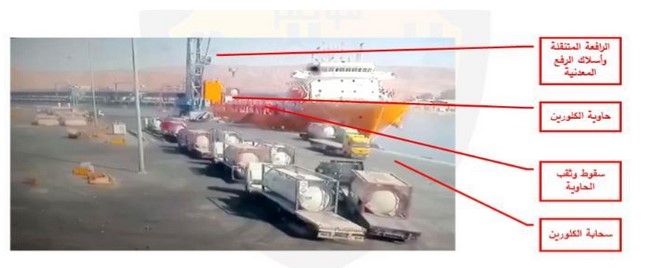
- الباخرة Forest6
- رافعة متنقلة. Mobile Crane
- أسلاك رفع معدنية. Wire Rope Slings
- حاوية متنقلة سعة (28.9 طن). تحتوي على الكلورين المضغوط المُسَال.
28.9-Ton Portable T50 ISO Tanks Containing Pressurized Liquified Chlorine
- أعمدة. CatWalk Poles
- ثقب الحاوية. Container Rupture
- الرافعة المتنقلة وأسلاك الرفع المعدنية.
- حاوية الكلورين.
- سقوط وثقب الحاوية.
- سحب الكلورين.

خطر الكلورين:
تسلسل الأحداث:
- (١٣ وفاة)، وأكثر من (٢٥٠ إصابة).
- رياح من الشمال الغربي إلى الجنوب الغربي.
- ميناء العقبة:
- الشاطئ الجنوبي:
- مخطط تسلسل الأحداث:
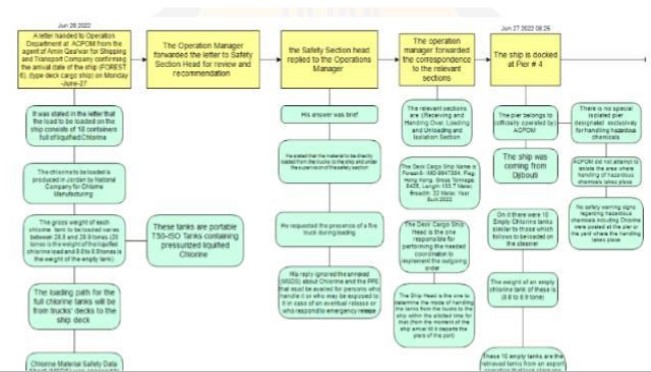


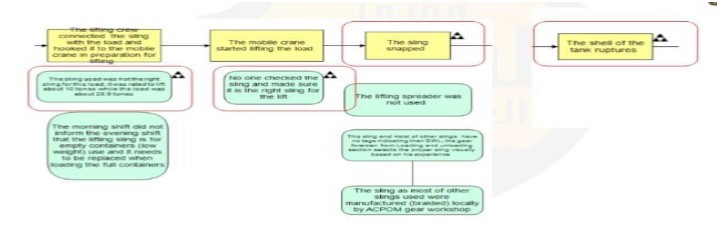

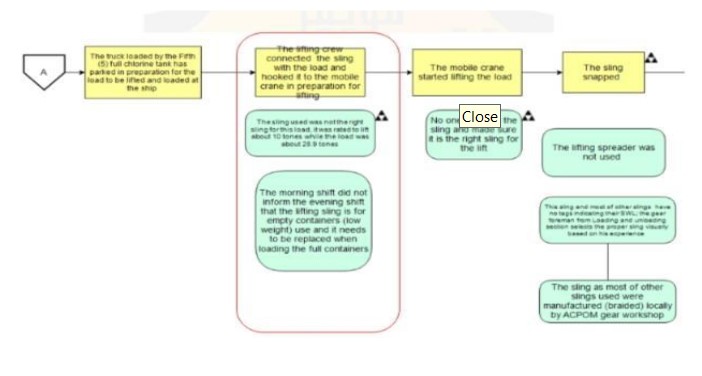
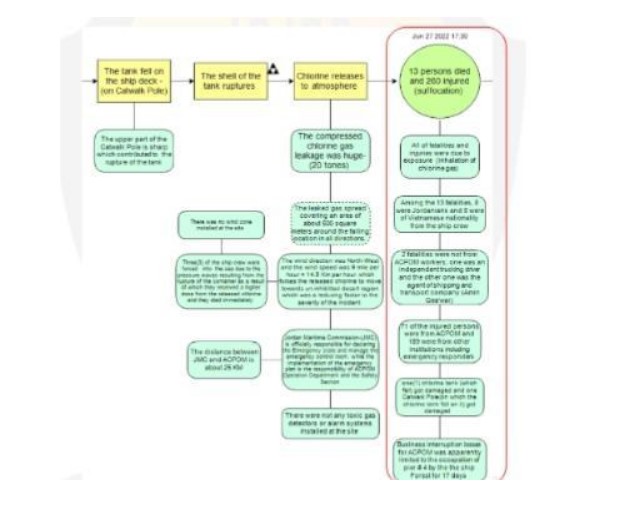
تعريف العامل المُسبِّب:
العامل المُسبِّب: هو خطأ بشري، أو قصور في المُعدَّة، والذي يؤدي مباشرةً – أو يتسبَّب – في حادثٍ ما، أو يخفق في التخفيف من العواقب الناجمة عن الخطأ الأصلي.
العوامل المُسبِّبة المرجحة لهذا الحادث:
- The Sling Snapped.
- The tank ruptures.
- The sling used was not the right sling for the load; it was rated to lift 10 tones while the load was about 28.9 tones.
- No one checked the sling and made sure it was the right sling for the load.
تعريف السبب الجذري للحادث:
هو غياب ممارسة فضلى، أو الإخفاق في تطبيق معرفة ما، والتي كان من شأنها أن تمنع المشكلة، أو تقلل بشكل ملحوظ من احتمالية تكرارها، أو من العواقب.
الأسباب الجذرية المرجحة لهذا الحادث:
- Management System- SPAC Need Improvement: No Standards, PolIcies, or Administrative Controls (SPAC)
- Work Direction- Preparation: No preparation
- Work Direction-Preparation: Work Package/Permit Needs Improvement
- Communication-Turnover Needs Improvement: No standard turnover process
- Communication- No Communication or Not Timely: Communication Hardware needs improvement
- Procedures-Not Used/Not Followed: No procedure (checklist structured).
الإجراءات التصحيحية/ الدروس المستفادة:
- Conduct a survey to determine communication requirements during normal operations and emergencies.
- Establish a stringent Shift Turnover Policy-(Checklist Structured).
- Effectively Communicate this policy to all relevant supervisory personnel at all levels.
- Conduct on-the-job training for shift supervisors and all shift crew on the use of this policy.
- Establish a policy that addresses handling, lifting, loading, and unloading of all hazardous chemical substances.
- Establish a comprehensive policy-(checklist structured) that addresses all elements of safe lifting operations. The policy must include identification, Inspection, testing, rating, tagging, and color coding of all lifting tools Including slings.
- Effectively communicate these policies to all relevant departments and personnel.
- Train those who will be involved in implementing these policies on how to practically and effectively implement these policies.
- Perform regular audits to monitor performance and compliance.
- Implement Pre-job briefing, job safety analysis, pre-job walk-throughs, and prepared checklists for all needed safety controls.
- Train All relevant Supervisory personnel on the application of the above procedure.
- Review and update the current work package and improve it to address key elements like:
-
- Equipment Identification
- Work Methods
- Work Sequence
- Coordination between groups and teams
- Safety precautions and warnings
- Procedures, policies and standards to be used
- Plant conditions to be met
- All types of safety permits and
- The applicable Material Safety Data Sheet
- Train all work planners and relevant supervisors on the newly improved work package.
- Perform a professional study by specialized experts to re-engineer the facility siting , to designate one or two quays for temporary storage, handling and lifting operations of hazardous chemicals.
- Install the needed protection and emergency control systems for these selected quays to combat any possible emergency-(chemicals leakage, release, fire, explosIon and other possible or potential risks).
- Review the entire Emergency management System including emergency response and evacuation plans, emergency communication protocols, emergency equipment, rescue operations, training and emergency drills, evacuation routes and assembly points.
- Train emergency responders on hazardous chemical release response.
المحاضرين:
د/ سامي عمارنة
- رئيس جمعية مهندسي سلامة العمليات الكيميائية الأردنية.
- مُمثِّل المعهد العربي لعلوم السلامة في المملكة الأردنية الهاشمية.
- درجة الدكتوراه في الهندسة الكيميائية وحماية البيئة.
- خبير ومستشار معتمد في أنظمة إدارة الجودة والبيئة والسلامة.
- مدرب TapRoot معتمد.
م/ عمرو كشت
- نائب رئيس جمعية مهندسي سلامة العمليات الكيميائية الأردنية.
- عضو المعهد العربي لعلوم السلامة في المملكة الأردنية الهاشمية.
- درجة ماجستير في الهندسة الكيميائية.
- خبير ومستشار معتمد في سلامة العمليات والسلامة الوظيفية وتحليل المخاطر.






